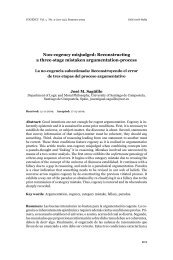Cogency v2 n2
Cogency v2 n2
Cogency v2 n2
You also want an ePaper? Increase the reach of your titles
YUMPU automatically turns print PDFs into web optimized ePapers that Google loves.
“A picture held us Captive”: The later Wittgenstein... / S. W. PATTERSON<br />
tation on temptation (Cézanne was, until the time of his death a devout<br />
Roman Catholic). One need not assume that any such statement is being<br />
made at all. The painting may sensibly be interpreted as an exercise in composition<br />
or color theory and appreciated as such, without any sort of connection<br />
to “deeper” or more hidden meanings. Who knows that this isn’t<br />
what Cézanne intended in the first place, and that he wouldn’t chuckle at<br />
highly intellectual attempts to infuse his works with meanings that reach<br />
beyond what the images themselves portray by nestling them within a highly<br />
complicated semiotic architecture? Maybe he just painted for the challenge<br />
of developing his technique, without thinking very deeply about subject<br />
matter at all (though I feel compelled to say that that seems highly doubtful<br />
to me). Sadly, he is no longer with us, and we cannot know for certain what<br />
meaning he intended to communicate in the vast majority of his works. All<br />
of those mentioned are latent possibilities and it is impossible to say that<br />
Cézanne would have been unhappy with any of them or that he would have<br />
intended some and not others, even if his primary purpose was to say something<br />
about painting to other painters.<br />
Visual images are such that the agent who makes them can intend multiple<br />
understandings, or simply intend that viewers reach some reading of<br />
the images she presents. This open-textured nature is the power of images,<br />
not their handicap. 14 An argument over what Cézanne’s painting means<br />
would thus have to be open-textured too. An argument over the meaning of<br />
the sentence ‘The cat is on the mat.’, by contrast, is far less open to alternative<br />
readings that do not do violence to communally held standards of interpretation<br />
and meaning. One has to leverage the context of the utterance to<br />
extract non-standard accounts of what the statement means, i.e. to assume<br />
that the context of the utterance was in the course of a long poem in which<br />
‘cat’ and ‘mat’ were being used metaphorically. It is not so with the painting.<br />
14<br />
Though the Wittgensteinian diagnosis of the failure of pictures to be arguments on<br />
offer here bears some similarities to that offered in Fleming (1996), it is at the point of<br />
asking what pictures actually do where I suspect the two analyses would cease altogether<br />
running in parallel directions. Fleming spends considerable time on the question of what<br />
pictures actually can and cannot do. In keeping with the notion that images are open-textured,<br />
or semantically polyvalent, I wish simply to say that this fact about them prevents us<br />
from pinning down any one function they might have, sui generis. Though they cannot be<br />
arguments on the analysis given here, the roles that images play in argumentation or persuasion<br />
may be many and varied indeed.<br />
131








